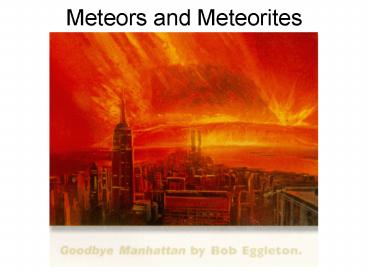Meteors and Meteorites - PowerPoint PPT Presentation
Title:
Meteors and Meteorites
Description:
named for constellation containing the radiant point. Leonids shown here or plotted... plotted back to radiant in Leo. Caused by perspective the artist's ' ... – PowerPoint PPT presentation
Number of Views:376
Avg rating:3.0/5.0
Title: Meteors and Meteorites
1
Meteors and Meteorites
2
Meteoroids - still in space
3
Shooting Stars
- Size of a pea
- velocities of 10s km/sec
- 6/hour sporadic rate (any night)
4
Bolides or fireballs
5
Sometimes seen in daytime
6
Sometimes break up
7
Meteor train can persist
8
If hit meteorites
9
Meteor showers occur when we cross paths of a
broken up comet
Here the Persieds named
10
named for constellation containing the radiant
point
Leonids shown here or plotted
11
plotted back to radiant in Leo
12
Caused by perspective the artists vanishing
point
Driving in snow
13
Major showers
Handout
14
Leonids spectacular every 33 years
- Due to lumpiness in distribution of old comet
within orbit - This woodcut from 1833 100,000/hour
- My first chance 1966
- Most recent 2000-2002-who saw?
15
Meteors better after midnight
But
16
Meteorites types
Carbonaceous
Iron-nickel
Iron
Stony
17
Iron most commonly found but more stony
meteorites more common!
18
Widmanstatten patterns
19
Stony meteorites 93 of all meteorites
20
Show chondrules (round stones) when cut and
polished
21
Stony-irons show a mix
22
Carbonaceous chondrites
- this at right from 1969 Allende fall in Mexico
- Primordial in content
- Contain volatiles
- Organics
- Radioactive nuclei 26Al may be from supernova
that sparked the formation of our solar system
23
Model to explain the variety
24
Barringer crater in Arizona
1.2 km diameter, 25,000 years ago, 11 km/s 20
Mton bomb
25
Drilling found the rock
26
41-mile diameter crater in Quebec
27
Tunguska
Heard for 1000 km. Small comet? What if
had happened 60 70 years later?
28
Walter and Luis Alvarez found iridium clay layer
at Cretacous-Tertiary boundary (65My ago)
Traced impact to
29
Chicxulub Impact structure
- A bad day for dinosaurs
- Expect such hits every 8 million years
- May find a kilometer within 10-20 years
- Need to look for 100-m objects
- Need a wakeup call?
30
Thats all. Have a nice day!































